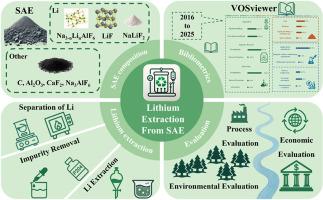从废铝电解液中回收锂的研究进展:机制、经济和环境评价
IF 16.3
1区 工程技术
Q1 ENERGY & FUELS
引用次数: 0
摘要
废铝电解液(SAE)是铝电解过程中产生的富锂固体废弃物,其锂含量高于低品位锂矿石,是一种很有前景的锂回收二次资源。本文首先对sae相关锂回收研究进行文献计量分析,总结了近年来的发表趋势、研究热点和领先机构。然后系统地检查了SAE的化学成分和元素来源。当前的锂提取技术-包括湿法冶金和热法-湿法冶金联合工艺-进行了严格的审查,重点是氟,铝,钙和镁的杂质去除策略,以及它们各自对下游锂回收效率的影响。对处理1吨SAE进行了技术经济分析(TEA)。同时,进行了生命周期评估(LCA),比较了sae基锂提取工艺与传统矿基锂提取工艺的环境影响。最后,提出了工艺优化建议,为sae基锂回收的工业应用提供了参考。本文章由计算机程序翻译,如有差异,请以英文原文为准。

Critical review of lithium recovery from spent aluminum electrolyte: Mechanisms, economics, and environmental assessment
SAE (spent aluminum electrolyte), a lithium-rich solid waste generated during aluminum electrolysis, contains more lithium than low-grade lithium ores and thus represents a promising secondary resource for lithium recovery. This review begins with a bibliometric analysis of SAE-related lithium recovery research, summarizing publication trends, research hotspots, and leading institutions in recent years. The chemical composition and elemental origins of SAE are then systematically examined. Current lithium extraction technologies—encompassing hydrometallurgical and combined pyro-hydrometallurgical processes—are critically reviewed, with a focus on impurity removal strategies for fluorine, aluminum, calcium, and magnesium, and their respective impacts on downstream lithium recovery efficiency. A techno-economic analysis (TEA) was performed for the treatment of 1 ton of SAE. In parallel, a life cycle assessment (LCA) was conducted to compare the environmental impacts of SAE-based lithium extraction with those of traditional ore-based processes. Finally, recommendations for process optimization are proposed, providing insights into the industrial application of SAE-based lithium recovery.
求助全文
通过发布文献求助,成功后即可免费获取论文全文。
去求助
来源期刊

Renewable and Sustainable Energy Reviews
工程技术-能源与燃料
CiteScore
31.20
自引率
5.70%
发文量
1055
审稿时长
62 days
期刊介绍:
The mission of Renewable and Sustainable Energy Reviews is to disseminate the most compelling and pertinent critical insights in renewable and sustainable energy, fostering collaboration among the research community, private sector, and policy and decision makers. The journal aims to exchange challenges, solutions, innovative concepts, and technologies, contributing to sustainable development, the transition to a low-carbon future, and the attainment of emissions targets outlined by the United Nations Framework Convention on Climate Change.
Renewable and Sustainable Energy Reviews publishes a diverse range of content, including review papers, original research, case studies, and analyses of new technologies, all featuring a substantial review component such as critique, comparison, or analysis. Introducing a distinctive paper type, Expert Insights, the journal presents commissioned mini-reviews authored by field leaders, addressing topics of significant interest. Case studies undergo consideration only if they showcase the work's applicability to other regions or contribute valuable insights to the broader field of renewable and sustainable energy. Notably, a bibliographic or literature review lacking critical analysis is deemed unsuitable for publication.
 求助内容:
求助内容: 应助结果提醒方式:
应助结果提醒方式:


